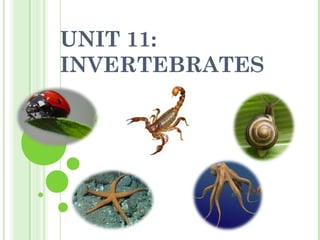
Unit 11. Invertebrates
- 2. CLASSIFICATION OF ANIMALS Two groups: Vertebrates: which have an internal skeleton with a backbone. Invertebrates: which don’t have an internal skeleton.
- 4. 1. PORIFERA Sponges are aquatic animals. Most of them are marine. They live attached to sand or rocks. The body is perforated by pores and supported by small needles called spicules. They have an internal cavity with an upper hole called osculum. They are filtering animals. They feed filtering water and retaining food particles. They can reproduce sexually or asexually (fragmentation or budding).
- 5. WATER CIRCULATION IN A SPONGE.
- 6. 2. CNIDARIA Cnidaria are aquatic animals. Most of them are marine. Examples: Corals, jellyfish, sea anemones, hydra. Cnidaria have two body forms: Swimming medusae:An umbrella shape floating freely. Sessile polyps: a bag shape fixed to the ground. They have a mouth with tentacles with stinging cells called cnidocytes and a gastrovascular cavity. They can reproduce sexually or asexually (budding) Cnidaria are carnivores and catch their prey.
- 7. ACTIVITIES 1.True or false? a)Asexual reproduction happens through internal fecundation. b) Budding is a kind of asexual reproduction. c) In viviparous animals the embryo develops inside the mother’s body. d) In oviparous animals the egg develops inside the mother’s body. 2.What is the main difference between vertebrates and invertebrates?
- 8. 3.Explain how porifera and cnidaria feed. 4.Copy and complete the following sentences in your notebook. a) Polyps have the shape of a ………… b)Medusae have the shape of an ………….. 5. True or false? a) Porifera live freely, floating on sea water. b) Porifera can reproduce sexually or asexually. c) Corals are porifera with the shape of a polyp. d) Cnidaria can reproduce sexually from eggs.
- 9. 3. WORMS Worm includes animals with a soft, elongated body. Three types: platyhelminthes, nematodes, annelids. PLATYHELMINTHES: are flat worms. They live in wet environments or can be parasites. Ex: Planaria and Taenia. NEMATODES: are cylindrical worms. They live in water, wet soil or parasites. Ex: Hookworms. ANNELIDS: are worms with segments. The body is long and divided in rings. They live in wet soil or water. They have specialised systems. Ex: earthworms, leeches.
- 10. 4. MOLLUSCS They are aquatic (squids, mussels, clams) and terrestrial animals (snails, slugs). Organs highly developed. Parts of the body: The head: contains the sense organs. The visceral mass: contains the internal organs. The muscular foot: to move around, excavate or catch the prey. They breath through lungs (terrestrial) or gills (aquatic). They reproduce sexually. Main groups: Gastropods (snail, slugs), Bivalves (mussels, oysters, clams), Cephalopods (squid, octopus, cuttlefish, nautilus)
- 12. ACTIVITIES 1. What is the main characteristic of nematodes? 2. Copy and complete this sentence in your notebook. Annelids’ bodies are…………. And divided into ………. or ……….. They live in ……… 3. What will happen if a earthworm lie in the sun? 4. What is the main characteristic of platyhelminthes?
- 13. 5. Draw an snail, a mussel and an octopus. 6. List the main body parts of a mollusc. 7. Write two molluscs that breathe through gills and lungs.
- 14. 5. ARTHROPODS They are terrestrial (spiders) or aquatic animals (crabs). The body is divided into segments. (head, thorax, cephalotorax, abdomen) They have hard appendages (antennas, legs, palps) The body is covered by a rigid and articulated exoskeleton. They breathe by gills (aquatic) or by tracheas (terrestrials). They reproduce sexually and some of them have complete or incomplete metamorphosis. Classification: Aracnids (spiders, scorpions, mites) Crustaceans (Crabs, shrimps, lobsters) Myriapods (Millipedes, centipedes) Insects (grasshopper, butterfly, fly, wasp…)
- 17. CHELICERATES MANDIBULATES CRUSTACEANS MYRIAPODS INSECTS
- 18. 6. ECHINODERMS They are marine animals. They have hard skeleton, generally with spines. They have an ambulacral system to move around. They reproduce sexually or by fragmentation like starfish. Examples: starfish, sea urchins, sea cucumber, brittle star.
- 19. ACTIVITIES 1. Make a list of 4 characteristics common to all arthropods. 2. What is metamorphosis? How many kinds of metamorphosis are there? 3. What is the main function of the exoskeleton? 4. Write down two examples of Chelicerates and four examples of Mandibulates. 5. Explain how Crustaceans breathe.
- 20. 6. Which system is exclusive to echinoderms? What is it used for? 7.True or false? a)The body of many echinoderms is covered by spines. b)Ambulacral system is used for reproduction. c)Echinoderms can reproduce sexually through eggs. 8.State which group of invertebrates the following animals belong to: a)Earthworms e)Jellyfish b)Snail f)Mussel c)Fly g)Sponge d)Scorpion h)Starfish
- 21. 9. Match each kind of invertebrate to its main characteristic. a) Molluscs 1.They have an ambulacral system. b)Arthropods 2.They have pores. c)Porifera 3.They have exoskeleton. d)Annelids 4.The mouth is sourronded by tentacles e)Echinoderms 5.Its body is very long and divided into segments. f)Cnidaria 6. Most of them have a shell. 10.Order the following animals from the most simple to the most complex: Fly, sponge, earthworm, mussel, jellyfish, taenia. 11. True or false? a) Echinoderms have an internal shell. b)All terrestrial arthropods breathe by lungs. c)All invertebrates have an endoskeleton. d)An annelid’s body is divided into rings.
